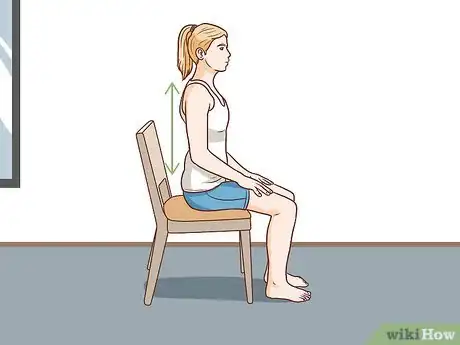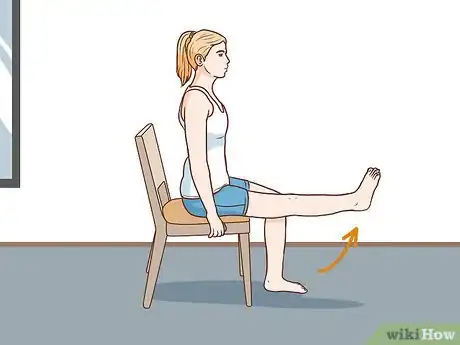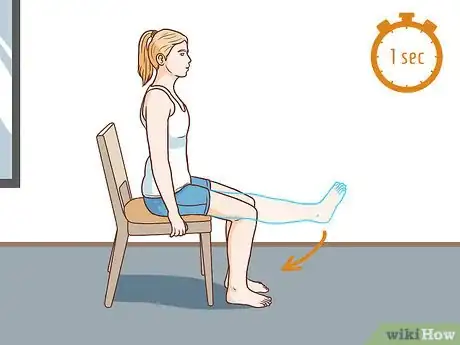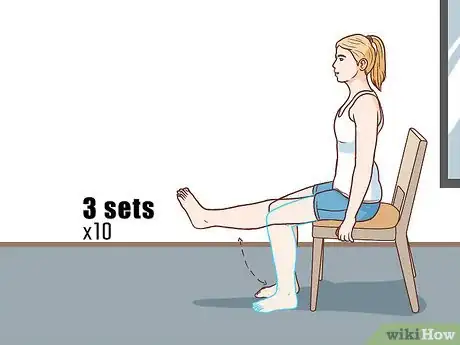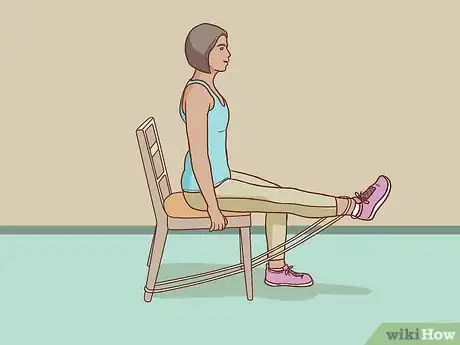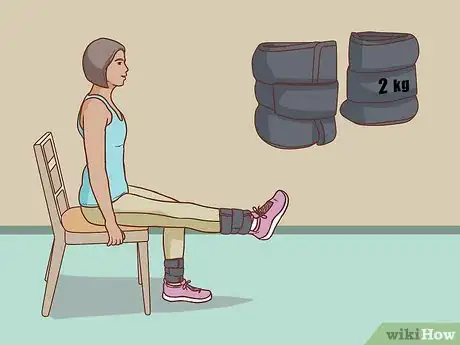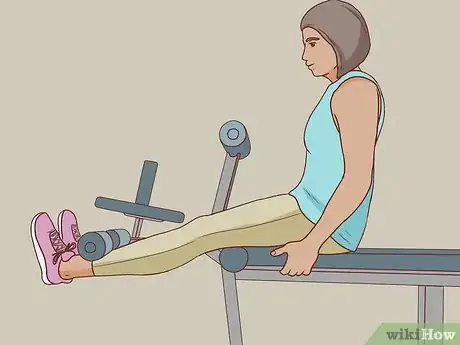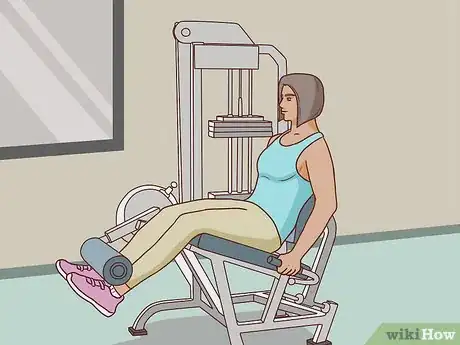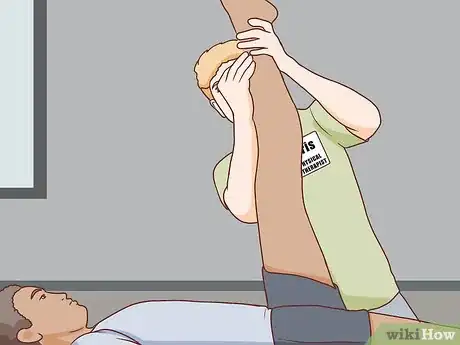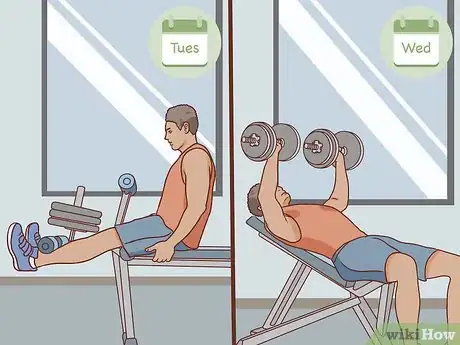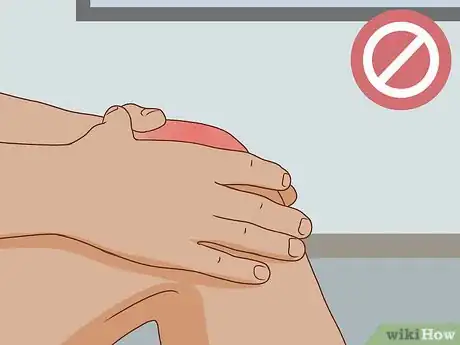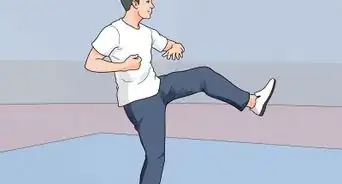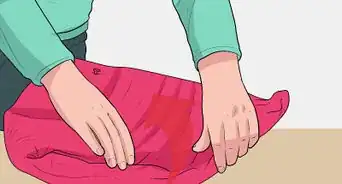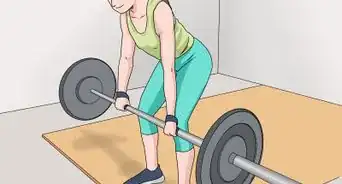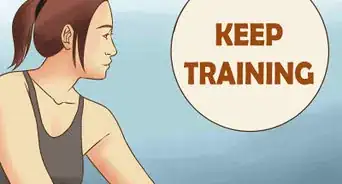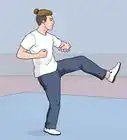This article was co-authored by Danny Gordon. Danny Gordon is an American College of Sports Medicine (ACSM) Certified Personal Trainer and Owner of The Body Studio for Fitness, a fitness studio based in the San Francisco Bay Area. With over 20 years of physical training and teaching experience, he has focused his studio on semi-private personal training. Danny received his Personal Trainer Certification from the California State University, East Bay and the American College of Sports Medicine (ACSM).
There are 8 references cited in this article, which can be found at the bottom of the page.
This article has been viewed 26,012 times.
Leg extensions are a great way to strengthen your thigh muscles and improve knee mobility.[1] As a plus, they can be performed with or without exercise equipment. To do basic leg extensions, sit in a chair with your knees bent and feet flat on the floor. Then straighten your legs and raise your feet toward the ceiling. If your goal is build your leg muscles, use ankle weights, resistance bands, or exercise machines to increase the difficulty. As with any exercise, maintain proper form, never try to push through pain, and check with your doctor before starting a new workout routine.
Steps
Doing Leg Extensions Without Equipment
-
1Begin by sitting up straight in a chair. Sit with your upper body straight against the back of the chair. Keep your shoulders back and look forward with your head in a neutral position. Place your hands by your sides and rest them on the chair’s seat or arms for support.[2]
- Sit with your knees and ankles hip-width apart, bend your knees at 90-degree angles, and keep your feet flat on the floor.
- Be sure that your chair allows you to bend your knees at 90-degree angles. If they’re bent at a smaller angle and aren’t aligned straight above your ankle, you may be putting extra stress on your joints.
-
2Raise the lower half of your legs so they’re in line with your thighs. Inhale, then exhale as you straighten your knees and raise your legs. Bring your shins and toes toward the ceiling so that they’re parallel with your thighs and the floor.[3]
- Be sure to use steady, slow motions instead of swinging your knees or using momentum to jerk your lower legs upward.
Variation: If you’re recovering from an injury or are just starting out, try raising 1 leg at a time.
Advertisement -
3Hold up your legs for 1 second, then lower them to the starting position. After keeping your legs lifted for a second, inhale as you slowly bend your knees. Using steady motions, lower your feet so they’re once again flat on the floor.[4]
- From the starting position with your feet on the floor, exhale and repeat the steps to perform the next rep.
-
4Do 3 sets of 10 leg extensions. Rest for 30 to 60 seconds between each set. As a general guide, do 3 sets of 10 reps, but check with your doctor, physical therapist, or a fitness professional for specific instructions.[5]
- If you’re raising 1 leg at a time, finish your set on the first leg, then switch sides. Perform the next set with the first leg, then do a set of 10 reps with the other.
Using Exercise Equipment
-
1Exercise with a resistance band for a little more difficulty. Hook one end of the band around the back right leg of your chair. Sit in the chair, loop the other end of the band around your right ankle, and grasp the seat of the chair for support. Then perform 1 set of 10 to 12 leg extensions with your right leg.[6]
- After the first set, loop the band's ends around the chair’s back left leg and your left ankle. Do a set of leg extensions with your left leg, then switch it up again and complete a second set on each side.
-
2Add ankle weights to focus on strength training. Strap weights around your ankles, sit in your chair, and perform leg extensions. Since you’re adding resistance, do 1 to 2 sets of 12 instead of 3 sets of 10.[7]
- Try starting out with 5 pound (2.3 kg) weights. They should offer a challenge, but you should still be able to complete your reps with smooth, steady motions.
- Ankle weights wrap around your lower shins and stay in place with Velcro straps. You can find them online, at major retailers, and at sporting and gym equipment stores.
Tip: Increase your weights gradually as your workouts become easier. Try increasing your weights by about 10% every 1 to 2 weeks.
-
3Do leg extensions on a weight bench with leg rollers. Many weight benches have an attachment at one end that has padded rollers that you can add weight to and use for leg extensions. Position your legs behind the attachment so the roller pads rest against your lower shins.[8]
- If your bench has an adjustable seat, raise it so you can sit up straight with your feet flat on the floor, your knees bent at 90-degree angles.
- Grasp the seat of the bench for support as you do 2 sets of 10 to 12 leg extensions.
- You can load free weights onto the leg attachment to increase the difficulty. Always start out with fewer weights to avoid hurting yourself. Add weight until your muscles are challenged but you’re still able to finish a full set while maintaining proper form.
-
4Use a leg extension machine at the gym for the toughest workout. A leg extension machine is a chair that has a padded bar that rests against your shins that you use to add weight resistance when you extend your legs. Find the knob that adjusts the machine’s leg pad, set the weight, sit in the machine, grasp the handles by your sides, and do 2 sets of 12 leg extensions.[9]
- Set your machine to a weight that’s challenging but still allows you to complete a full set with slow, steady motions. For example, start with a set of 12 repetitions at 50 pounds (23 kg) and add more weight to your next set if you need to.
- Adjust the pad so it sits just above your feet, and set the seat so you can sit in it with your knees bent at 90-degree angles.
- With the pad resting against your shins, straighten your legs and raise your feet toward the ceiling. Keep your legs lifted for 1 second, then inhale as you lower them to the starting position.
- Be sure that your knees are bent at 90-degree angles and aligned over your ankles. If the angle is smaller and your knees extend past your ankles, you’ll put too much stress on your knee joints.
- See a fitness professional at your gym for specific instructions and safety warnings.
Sticking to a Safe Workout Routine
-
1Check with your doctor if you’re not used to exercising. Ask them for advice about becoming more active before you start a new exercise routine. It’s especially important to check with a medical professional if you have a history of medical issues or have recently suffered an injury.[10]
- Additionally, if you have an illness or injury, ask your doctor or physical therapist about exercises you should try and those you should avoid.
-
2Warm up and cool down before and after your workouts. Before any workout, walk briskly or jog lightly for at least 5 minutes to warm up your muscles. Jumping jacks and jogging in place are also good warm-ups. After your workout, walk or jog for another 10 to 15 minutes to ease your muscles back into a resting state.[11]
- Working out or stretching muscles without warming up poses an injury risk. Cooling down after a workout can help prevent cramping.
-
3Do leg extensions no more than every other day. Include leg extensions on your leg strength training days, then focus on a different group the next day. Your muscles need a rest day to recover after a tough workout.[12]
- For example, do 2 sets each of squats, lunges, leg presses, calf raises, hamstring curls, and leg extensions on Tuesday. Then, on Wednesday, give your legs a break and focus on your core or upper body.
-
4Stop exercising if you experience pain. Listen to your body and never try to push through pain. Additionally, don’t exceed your body’s natural range of motion. If you do experience pain, avoid exercising and try to rest your legs until you feel better.[13]
- See your doctor if you experience serious or persistent muscle or joint pain.
Tip: Maintaining proper form can help minimize joint stress. At the starting position, remember to align your knees with your ankles, use smooth, controlled motions, and don’t lock your knees when you straighten your legs.
Expert Q&A
Did you know you can get expert answers for this article?
Unlock expert answers by supporting wikiHow
-
QuestionShould I do leg extensions?
 Danny GordonDanny Gordon is an American College of Sports Medicine (ACSM) Certified Personal Trainer and Owner of The Body Studio for Fitness, a fitness studio based in the San Francisco Bay Area. With over 20 years of physical training and teaching experience, he has focused his studio on semi-private personal training. Danny received his Personal Trainer Certification from the California State University, East Bay and the American College of Sports Medicine (ACSM).
Danny GordonDanny Gordon is an American College of Sports Medicine (ACSM) Certified Personal Trainer and Owner of The Body Studio for Fitness, a fitness studio based in the San Francisco Bay Area. With over 20 years of physical training and teaching experience, he has focused his studio on semi-private personal training. Danny received his Personal Trainer Certification from the California State University, East Bay and the American College of Sports Medicine (ACSM).
Certified Personal Trainer
Warnings
- Check with your doctor before starting a new exercise routine if you’re not used to exercising, if you have a history of medical issues, or if you’re recovering from an injury.⧼thumbs_response⧽
References
- ↑ Danny Gordon. Certified Personal Trainer. Expert Interview. 18 October 2019.
- ↑ https://orthoinfo.aaos.org/en/recovery/knee-conditioning-program/
- ↑ https://orthoinfo.aaos.org/en/recovery/knee-conditioning-program/
- ↑ http://www.washingtonpost.com/wp-srv/health/fitness/exercises/seated-leg-extensions-with-band.html?noredirect=on
- ↑ https://www.emoryhealthcare.org/centers-programs/acl-program/prehabilitation/retain-muscle-size-strength.html
- ↑ http://www.washingtonpost.com/wp-srv/health/fitness/exercises/seated-leg-extensions-with-band.html?noredirect=on
- ↑ https://www.mayoclinic.org/healthy-lifestyle/fitness/multimedia/knee-extension/vid-20084686
- ↑ https://www.youtube.com/watch?v=MGmgzAzwQWk&feature=youtu.be&t=8
- ↑ https://www.bodybuilding.com/exercises/leg-extensions
- ↑ https://www.iofbonehealth.org/exercise-recommendations
- ↑ https://orthoinfo.aaos.org/en/recovery/knee-conditioning-program/
- ↑ https://www.emoryhealthcare.org/centers-programs/acl-program/prehabilitation/retain-muscle-size-strength.html
- ↑ https://orthoinfo.aaos.org/en/recovery/knee-conditioning-program/

